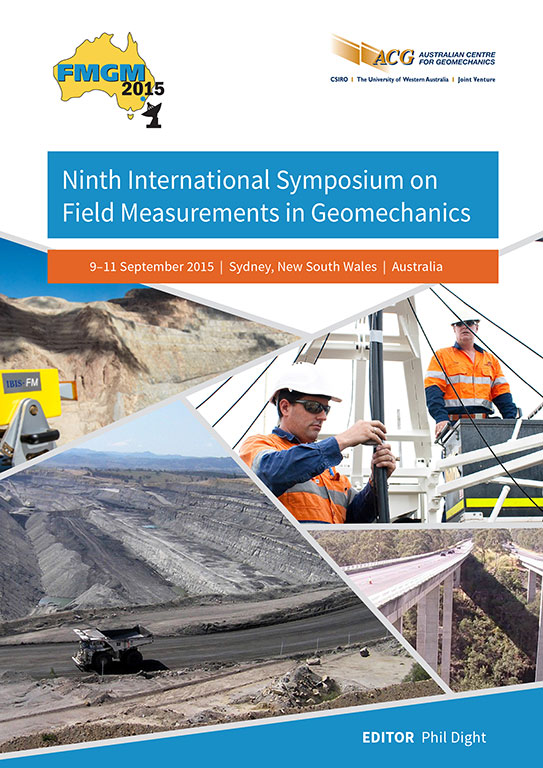Field instrumentation of a preloading project with prefabricated vertical drains

|
Authors: Mehdizadeh, A; Fakharian, K |
DOI https://doi.org/10.36487/ACG_rep/1508_30_Mehdizadeh
Cite As:
Mehdizadeh, A & Fakharian, K 2015, 'Field instrumentation of a preloading project with prefabricated vertical drains', in PM Dight (ed.), FMGM 2015: Proceedings of the Ninth Symposium on Field Measurements in Geomechanics, Australian Centre for Geomechanics, Perth, pp. 453-464, https://doi.org/10.36487/ACG_rep/1508_30_Mehdizadeh
Abstract:
Excessive consolidation settlements are always considered major threats for construction on soft soils. There are different methods to improve the soft cohesive sublayers. Preloading with vertical drains as one of the cheapest methods was selected for a ground improvement project in southwest of Iran near the Persian Gulf. The construction steps included soil instrumentation such as vibrating wire and Casagrande piezometers, magnetic extensometer, surface settlement monument, inclinometer, installation of prefabricated vertical drains (PVDs) and placement of embankment as a surcharge to accelerate the consolidation time for construction of two water tanks with a total volume of 100,000 m3. The length and spacing of PVDs for both water tanks were 15 and 1.5 m, respectively. This paper presents and compares instrumentation results in different soil layers for both water tanks and investigates the effects of loading rate and its consequences. In addition, back-analyses were carried out using the hyperbolic and Asaoka methods, on the basis of which some recommendations are provided for the instrument installation in soil layers and result interpretations. The findings demonstrate that the instrumentation is an indispensable part of preloading projects, owing to difficulties of evaluating the smear zone effects, design parameters and unpredicted problems during the project progress. Service time of PVDs and instruments, especially piezometers, must be considered for required time of consolidation and the Asaoka method predicts maximum settlements better than the hyperbolic method for this project.
References:
Abuel-Naga, HM, Pender, MJ & Bergado, DT 2012, ‘Design curves of prefabricated vertical drains including smear and transition zones effects’, Geotextiles and Geomembranes, vol. 32, pp. 1-9.
Arulrajah, A, Nikraz, H & Bo, MW 2004, ‘Factors affecting field instrumentation assessment of marine clay treated with prefabricated vertical drains’, Geotextiles and Geomembranes, vol. 22, pp. 415-437.
Asaoka, A 1978, ‘Observation procedure of settlement prediction’, Soils and Foundation, vol. 18, no. 4, pp. 89-101.
Basu, D & Prezzi, M 2009, ‘Design of prefabricated vertical drains considering soil disturbance’, Geosynthetics International, vol. 16, no. 3, pp. 147-157.
Basu, D, Basu, P & Prezzi, M 2007, ‘Analytical solutions for consolidation aided by vertical drains’, Geomechanics and Geoengineering: An International Journal, vol. 1, no. 1, pp. 63-71.
Bhosle, P & Vaishampayan, VV 2009, ‘Case study for ground improvement using PVD with preloading for coal and iron ore stackyard’, Proceedings of the Annual Conference of the Indian Geotechnical Society, pp. 506-509.
Cao, LF, Chang, M, Teh, CI & Na, YM 2001, ‘Back-calculation of consolidation parameters from field measurements at a reclamation site’, Canadian Geotechnical Journal, vol. 38, no. 4, pp. 755-769.
Chai, JC & Hayashi, S 2006, ‘Characteristics of vacuum consolidation’, Proceedings of the 16th International Conference on Soil Mechanics and Geotechnical Engineering, Millpress, Rotterdam.
Fakharian, K & Mehdizadeh, A 2015, ‘Investigation of field instrumentation in a preloading project’, Proceedings of the Institution of Civil Engineers Geotechnical Engineering, vol. 168, no. 1, pp. 87-98.
Gibson, RE, England, GL & Hussey, MJL 1967 ‘The theory of one dimensional consolidation of saturated clays, 1: finite non-linear consolidation of thin homogeneous layers’, Geotechnique, vol. 17, no. 3, pp. 261-273.
Hansbo S 1979, ‘Consolidation of clay by band-shaped prefabricated drains’, Journal of Ground Engineering, vol. 12, no. 5,
pp. 16-25.
Indraratna, B, Sathananthan, I, Rujikiatkamjorn, C & Balasubramaniam, AS 2005, ‘Analytical and numerical modelling of soft soil stabilized by prefabricated vertical drains incorporating vacuum preloading’, International Journal of Geomechanics, vol. 5, no. 2, pp. 114-124.
Liu, JC & Griffiths, DV 2014, ‘A general solution for 1D consolidation induced by depth- and time-dependent changes in stress’, Geotechnique, vol. 10, no. 1, pp. 1-7.
Rujikiatkamjorn, C & Indraratna, B 2009, ‘Design procedure for vertical drains considering a linear variation of lateral permeability within the smear zone’, Canadian Geotechnical Journal, vol. 46, no. 3, pp. 270-280.
Rujikiatkamjorn, C, Indraratna, B & Chu, J 2008, ‘2D and 3D numerical modelling of combined surcharge and vacuum preloading with vertical drains’, International Journal of Geomechanics, vol. 8, no. 2, pp. 144-156.
Shen, S, Chai, J, Hong, Z & Cai, F 2005, ‘Analysis of field performance of embankments on soft clay deposit with and without
PVD-improvement’, Geotextiles and Geomembranes, vol. 23, pp. 463-485.
Sridharan, A & Sreepada, RA 1981, ‘Rectangular hyperbola fitting method for one-dimensional consolidation’, Geotechnical Testing Journal, vol. 4, no. 4, pp. 161-168.
Sridharan, A, Murthy, NS & Prakash, K 1987, ‘Rectangular hyperbola method of consolidation analysis’, Geotechnique, vol. 37, no. 3, pp. 355-368.
Tan, SA 1995, ‘Validation of hyperbolic method for settlement in clays with vertical drains’, Soils and Foundation, vol. 35, no. 1,
pp. 101-113.
Terzaghi, K 1943, Theoretical soil mechanics, John Wiley & Sons, New York.
Wu, H & Hu, L 2012, ‘Analytical and numerical solutions for vacuum preloading considering a radius related strain distribution’, Mechanics Research Communications, vol. 44, pp. 9-14.
© Copyright 2025, Australian Centre for Geomechanics (ACG), The University of Western Australia. All rights reserved.
View copyright/legal information
Please direct any queries or error reports to repository-acg@uwa.edu.au
View copyright/legal information
Please direct any queries or error reports to repository-acg@uwa.edu.au